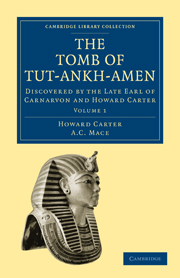Book contents
- Frontmatter
- Preface
- Contents
- LIST OF PLATES
- INTRODUCTION. BIOGRAPHICAL SKETCH OF THE LATE LORD CARNARVON
- CHAPTER 1 THE KING AND THE QUEEN
- CHAPTER 2 THE VALLEY AND THE TOMB
- CHAPTER 3 THE VALLEY IN MODERN TIMES
- CHAPTER 4 OUR PREFATORY WORK AT THEBES
- CHAPTER 5 THE FINDING OF THE TOMB
- CHAPTER 6 A PRELIMINARY INVESTIGATION
- CHAPTER 7 A SURVEY OF THE ANTECAMBER
- CHAPTER 8 CLEARING THE ANTECHAMBER
- CHAPTER 9 VISITORS AND THE PRESS
- CHAPTER 10 WORK IN THE LABORATORY
- CHAPTER 11 THE OPENING OF THE SEALED DOOR
- APPENDIX
- INDEX
- Plate section
- Plate section
CHAPTER 8 - CLEARING THE ANTECHAMBER
Published online by Cambridge University Press: 07 October 2011
- Frontmatter
- Preface
- Contents
- LIST OF PLATES
- INTRODUCTION. BIOGRAPHICAL SKETCH OF THE LATE LORD CARNARVON
- CHAPTER 1 THE KING AND THE QUEEN
- CHAPTER 2 THE VALLEY AND THE TOMB
- CHAPTER 3 THE VALLEY IN MODERN TIMES
- CHAPTER 4 OUR PREFATORY WORK AT THEBES
- CHAPTER 5 THE FINDING OF THE TOMB
- CHAPTER 6 A PRELIMINARY INVESTIGATION
- CHAPTER 7 A SURVEY OF THE ANTECAMBER
- CHAPTER 8 CLEARING THE ANTECHAMBER
- CHAPTER 9 VISITORS AND THE PRESS
- CHAPTER 10 WORK IN THE LABORATORY
- CHAPTER 11 THE OPENING OF THE SEALED DOOR
- APPENDIX
- INDEX
- Plate section
- Plate section
Summary
Clearing the objects from the Antechamber was like playing a gigantic game of spillikins. So crowded were they that it was a matter of extreme difficulty to move one without running serious risk of damaging others, and in some cases they were so inextricably tangled that an elaborate system of props and supports had to be devised to hold one object or group of objects in place while another was being removed (see Plate XXVI). At such times life was a nightmare. One was afraid to move lest one should kick against a prop and bring the whole thing crashing down. Nor, in many cases, could one tell without experiment whether a particular object was strong enough to bear its own weight. Certain of the things were in beautiful condition, as strong as when they first were made, but others were in a most precarious state, and the problem constantly arose whether it would be better to apply preservative treatment to an object in situ, or to wait until it could be dealt with in more convenient surroundings in the laboratory. The latter course was adopted whenever possible, but there were cases in which the removal of an object without treatment would have meant almost certain destruction.
There were sandals, for instance, of patterned bead-work, of which the threading had entirely rotted away. As they lay on the floor of the chamber they looked in perfectly sound condition, but, try to pick one up, and it crumbled at the touch, and all you had for your pains was a handful of loose, meaningless beads.
- Type
- Chapter
- Information
- The Tomb of Tut-Ankh-AmenDiscovered by the Late Earl of Carnarvon and Howard Carter, pp. 123 - 140Publisher: Cambridge University PressPrint publication year: 2010First published in: 1923



